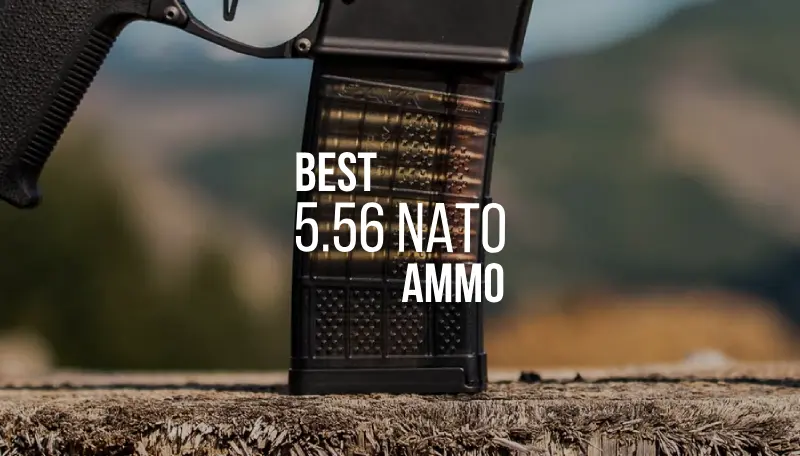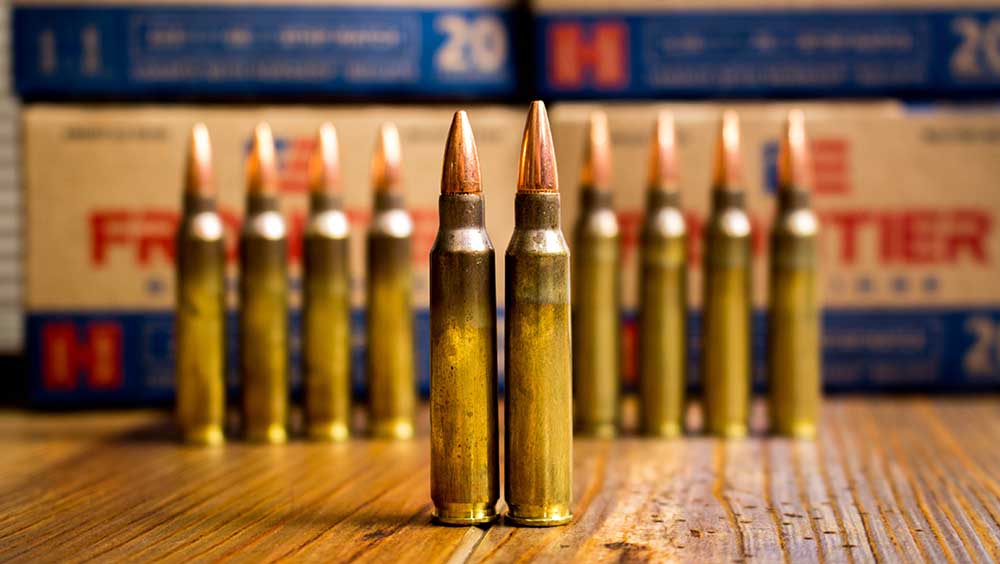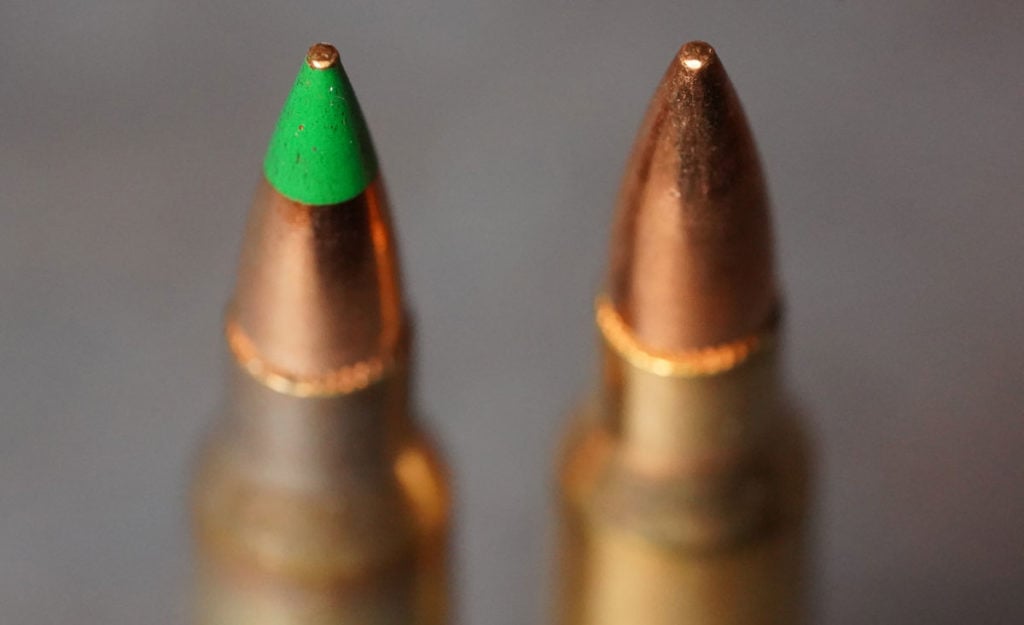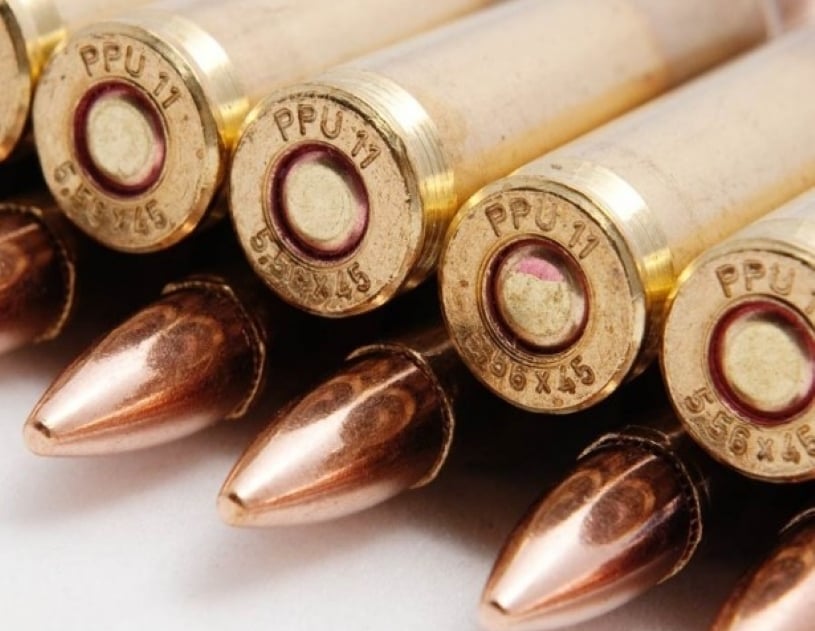
Today, America’s most beloved rifle platform, the AR-15, is typically manufactured in 5.56mm NATO, though there are options in non-traditional calibers, such as .300 AAC Blackout and 6.5 Grendel. Alternative cartridges bring their benefits and downsides to the system, eventually making it more suitable for one application and less suitable for others. However, the 5.56 NATO will always be considered the best AR-15 ammo due to its impressive versatility.
But why is that? To answer this question, we need to touch upon the history of cartridge creation.
History of the 5.56 NATO
In the 50s, the US Army outlined the requirement for the cartridge to be used in the future lightweight small-caliber rifle that would become a new standard-issue combat rifle for the military. In particular, these requirements included a .22 caliber bullet that would have ballistics of the 30-06 Springfield, retain subsonic velocity at 500 yards, and penetrate a steel helmet and a .135-inch steel plate at this distance. The cartridge should allow for a 20-round magazine capacity, rifle weight not exceeding 6 pounds, and switch from semi-auto to full-auto.
As you see, the development of a cartridge is inseparable from the development of the rifle in which it was going to be used. The result was the civilian .223 Remington cartridge intended for the AR-15 rifle introduced by the Armalite in the late 50s. Several years later, the military adopted the new combo as the M16 rifle and the 5.56 NATO cartridge.

5.56 NATO vs. 223 Rem
Though the 5.56 NATO was developed based on the .223 Remington, it doesn’t mean you can use the cartridges interchangeably. Both of them are nearly identical in terms of the external dimensions. The difference is inside the case and, surprisingly, the rifle.
The 5.56 NATO has slightly thicker walls and, thus, less case capacity, which leads to more pressure from burning the same amount of powder in a smaller space. It’s hard to compare the cartridges in terms of pressure since civilian and military testing techniques are different. But typically, the 5.56 NATO is a higher-pressure round than the .223 Remington.
Another difference lies in the rifle chambers. Everything in a 5.56 chamber is longer and thicker to withstand the higher pressures of the 5.56 cartridge. It means it’s completely safe to use .223 ammo with a 5.56 rifle, but it’s not recommended to do the other way around. A .223 chamber merely has less space for the 5.56 round to build up the pressure safely.
Though many shooters fire the 5.56 NATO from a .223 Rem rifle and don’t experience any immediate malfunctions and accidents, repeated exposure to higher pressures can lead to problems later. So you’d better stick to your rifle specifications.
Which 5.56 Ammo is Best – 5.56 Ammo Types
Before we touch on what is the best 5.56 ammo, we should run through the types of 5.56 ammo for you to choose the right load for your application. When the military created its own variant of the civilian .223 Rem, its name precisely was “Cartridge, 5.56mm ball, M193.” The M193 accepted a 55-grain projectile that was full metal jacketed and boat-tailed for improved flight performance. However, such a lightweight bullet was still insufficient for penetrating hard targets at long range.
So, in 1980, the upgraded 5.56 NATO cartridge came to the scene, the M855. The M855 had a heavier 62-grain bullet which, again, was full metal jacketed and boat-tailed but also had a steel core instead of a lead core used in the original M193. The military decided to paint steel-core bullet tips of the new M855 in green to aid in distinguishing between the two loads. That’s how green-tip rounds appeared.

Many believe green-tipped 5.56 NATO rounds are armor-penetrating, but that’s a misconception. The steel used in the M855 core is actually softer than the one typically used in armor plates. Softer steel versus harder steel? The logic suggests the latter wins.
However, the M855 is still effective against other hard objects, such as cinder blocks. On the other hand, once an M193 bullet hits a hard target, its lead core disintegrates and deforms earlier, which adversely impacts penetration.
Despite the inferior penetrating capabilities of a lead core, a higher velocity of a lighter M193 bullet makes the cartridge suitable for situations where you need a projectile that flies faster and longer. At short range, say 100 yards, it shows a pretty decent penetration.
Now, can we use the 5.56mm NATO for hunting or self-defense? Well, it’s not recommended. It’s a military cartridge, which means most 5.56 ammo offerings will be FMJ. But why does the military use FMJ ammo? First of all, it’s cheaper and feeds more reliably. Also, FMJ bullets don’t expand on impact as hollow point and soft point projectiles of civilian cartridges intended for stopping the attacker by causing more damage. The basic concept reflected in the Hague Conventions is that warfare isn’t about killing all your enemies. It’s about forcing them out of action. That’s why it forbids the use of projectiles expanding and flattening in the human body.
Using FMJ ammo for defense or hunting isn’t recommended because of over-penetration. In a home defense situation, a bullet that goes right through the target can hit an innocent person, even if they are behind the wall. Hunting requires a cartridge that causes sufficient damage for a humane kill, like hollow point ammo with bullets that expand in the flesh. FMJs, on the other hand, are great for plinking, tactical practicing, or competition shooting.
Now let’s move on and consider the best 5.56 rounds.
Best 5.56 Ammo
Winchester 5.56 NATO 55gr FMJ 200-round box
The M193 ammo from Winchester is great for improving your shot at the range. The box contains 200 rounds with 55-grain full metal jacket bullets that exit the muzzle at a speed of 3270 fps with an energy of 1306 ft/lb. The rounds produce less barrel fouling, which translates into less frequent cleanings.
To wring out the most accuracy of 55-grain ammo, you need to fire it from a barrel with a slower twist rate of 1/9. A faster twist rate and a faster velocity will cause overstabilization leading to messed-up shot placement.
Winchester 5.56 NATO M855 62gr FMJ LC 20-round box
Want the famous lead-core M855 ammo? Winchester’s 62-grain rounds are the best 5.56 rounds for the 5.56 1×8 and 1×9 barrel since a faster twist rate does a better job at stabilizing heavier bullets. These bullets generate 3060 fps of muzzle velocity and 1289 ft/lb of muzzle energy.
Winchester 5.56 NATO M855 62gr FMJ LC 200-round box
The box contains the same M855 rounds with the same specifications as the mentioned Winchester’s 62-grain ammo, except that the box contains 200 rounds.
Hornady Black 5.56 NATO 62gr FMJ 20-round box
Hornady Black 5.56 ammo uses only high-quality cases, primers, and propellants for exceptional accuracy, consistency, and dependability. The rounds tested in a 20-inch barrel have 3060 fps of muzzle velocity and 1289 ft/lb of muzzle energy.
5.56 NATO Reloading

Many shooters wonder if they can and how to reload 5.56 ammo. Well, reloading is a great idea because it helps you save some money you would otherwise spend on new rounds. The brass used to manufacture cases is not getting any cheaper, while cases make a big cost of ammo. Besides, the AR ammo is always in high demand, which means sometimes it can disappear from store shelves. Also, consider the overall ammo shortage. The average price for 5.56 ammo fluctuates between $0.35 and $0.55 per round. Reloading can help lower the training and plinking cost.
Military cartridges are typically harder to reload because of the primer pocket type. Unlike civilian cartridges that use rolled pockets, military rounds often have their primer pockets crimped for increased reliability and durability. To reload a 5.56 NATO round, you’ll need to decrimp the primer pocket with a chamfering tool or a swager tool.
When reloading, remember that 5.56 NATO and .223 Remington are different cartridges, and while their reloading processes are pretty similar and require the same reloading dies, load data for them differs. So use appropriate data for the case you’re loading and don’t interchange.
We hope this guide will be helpful to novice shooters trying to make things clear and advanced gun owners who have more specific questions about the 5.56x45mm NATO. If you’re wondering where you can buy 5.56 ammo, look no further. Gritr Sports carries a variety of 5.56 NATO ammo from reputable brands, such as Winchester, Hornady, Federal, PMC, and others.
Check out our top deals for Guns For Sale and other “Best” articles on Gritr Sports:
FAQs
Which is the best 5.56 hunting round available?
Since 5.56 is basically the same round as the .223 Rem, we’d recommend you search for expandable .223 Rem hunting rounds with high penetration, such as the Remington Accutip or Nosler Expansion Tip. The 5.56 is a military cartridge, which means it’s available with non-expandable monolithic bullets – these aren’t recommended for hunting.
Can you recommend the best 5.56 ammo for deer hunting?
For deer hunting, you’d typically want a round with good penetration and expansion. The 5.56 NATO cartridge is a military ball round with a non-expandable FMJ bullet. They can overpenetrate on impacts and, thus, fail to cause enough tissue damage. Instead, we recommend expansion-tip .223 Rem ammunition for deer hunting. Also, don’t forget to check hunting laws and regulations in your area – some states prohibit hunting using 5.56 ammo.
What is the best 5.56 defense ammo to use?
The best 5.56mm defense ammo is usually one that offers reliable expansion and penetration, meaning, it should be .223 Rem, not 5.56 NATO. The Hornady TAP is highly regarded in this respect.
Is 5.56 ammo suitable for home defense?
5.56 NATO ammo with FMJ bullets isn’t suitable for home defense because they don’t expand on impact and can overpenetrate. On the other hand, the .223 Rem expandable ammo is a great choice for home-defense.




Leave a Reply